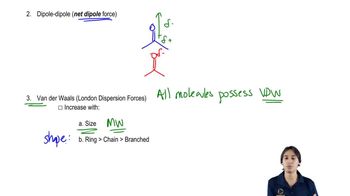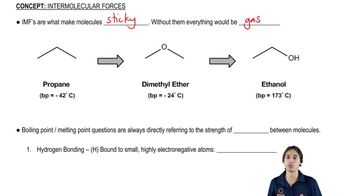For each pair of compounds, circle the compound you expect to have the higher boiling point. Explain your reasoning.
a. (CH3)3C—C(CH3)3 or (CH3)2CH—CH2CH2—CH(CH3)2
b. CH3(CH2)6CH3 or CH3(CH2)5CH2OH
c. CH3CH2OCH2CH3 or CH3CH2CH2CH2OH

 Verified step by step guidance
Verified step by step guidance Verified video answer for a similar problem:
Verified video answer for a similar problem:



 3:08m
3:08mMaster How IMFs are related to melting and boiling points. with a bite sized video explanation from Johnny
Start learning